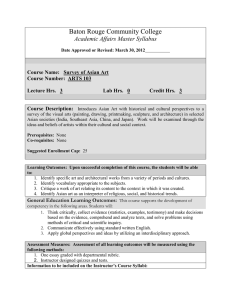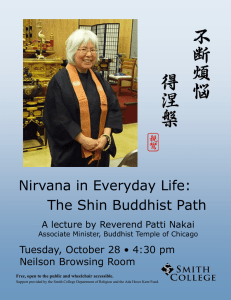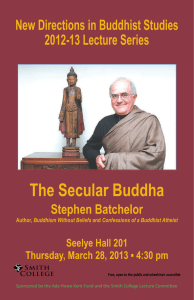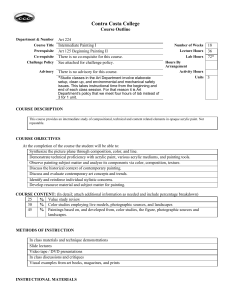College of San Mateo Official Course Outline COURSE ID: Semester Units/Hours:
advertisement
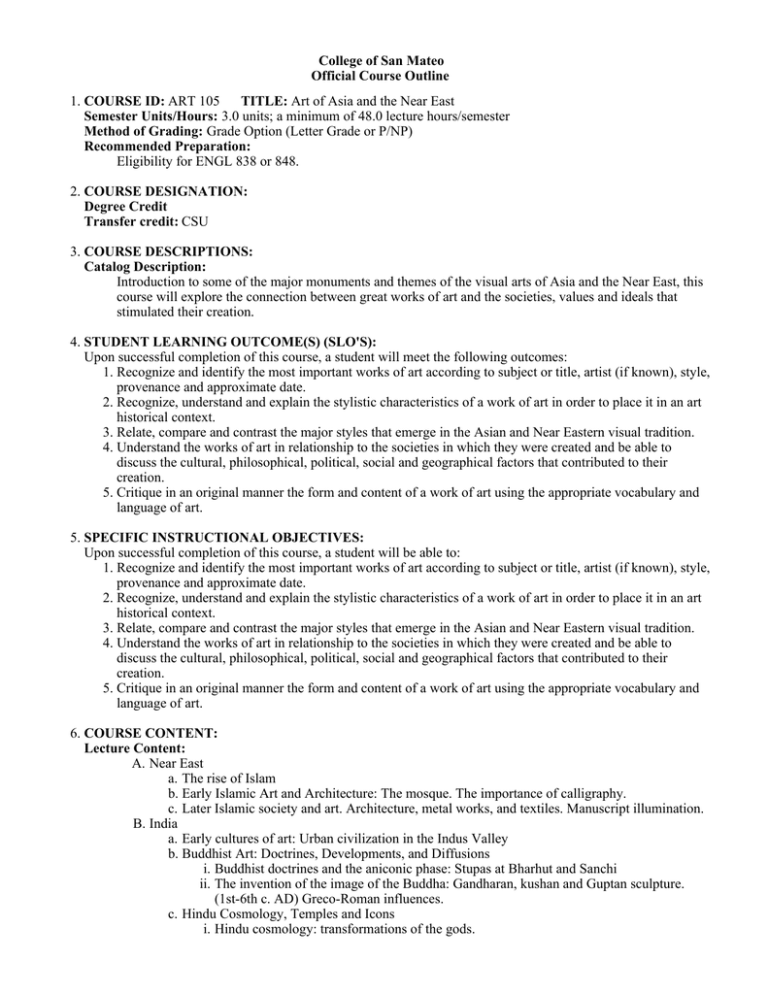
College of San Mateo Official Course Outline 1. COURSE ID: ART 105 TITLE: Art of Asia and the Near East Semester Units/Hours: 3.0 units; a minimum of 48.0 lecture hours/semester Method of Grading: Grade Option (Letter Grade or P/NP) Recommended Preparation: Eligibility for ENGL 838 or 848. 2. COURSE DESIGNATION: Degree Credit Transfer credit: CSU 3. COURSE DESCRIPTIONS: Catalog Description: Introduction to some of the major monuments and themes of the visual arts of Asia and the Near East, this course will explore the connection between great works of art and the societies, values and ideals that stimulated their creation. 4. STUDENT LEARNING OUTCOME(S) (SLO'S): Upon successful completion of this course, a student will meet the following outcomes: 1. Recognize and identify the most important works of art according to subject or title, artist (if known), style, provenance and approximate date. 2. Recognize, understand and explain the stylistic characteristics of a work of art in order to place it in an art historical context. 3. Relate, compare and contrast the major styles that emerge in the Asian and Near Eastern visual tradition. 4. Understand the works of art in relationship to the societies in which they were created and be able to discuss the cultural, philosophical, political, social and geographical factors that contributed to their creation. 5. Critique in an original manner the form and content of a work of art using the appropriate vocabulary and language of art. 5. SPECIFIC INSTRUCTIONAL OBJECTIVES: Upon successful completion of this course, a student will be able to: 1. Recognize and identify the most important works of art according to subject or title, artist (if known), style, provenance and approximate date. 2. Recognize, understand and explain the stylistic characteristics of a work of art in order to place it in an art historical context. 3. Relate, compare and contrast the major styles that emerge in the Asian and Near Eastern visual tradition. 4. Understand the works of art in relationship to the societies in which they were created and be able to discuss the cultural, philosophical, political, social and geographical factors that contributed to their creation. 5. Critique in an original manner the form and content of a work of art using the appropriate vocabulary and language of art. 6. COURSE CONTENT: Lecture Content: A. Near East a. The rise of Islam b. Early Islamic Art and Architecture: The mosque. The importance of calligraphy. c. Later Islamic society and art. Architecture, metal works, and textiles. Manuscript illumination. B. India a. Early cultures of art: Urban civilization in the Indus Valley b. Buddhist Art: Doctrines, Developments, and Diffusions i. Buddhist doctrines and the aniconic phase: Stupas at Bharhut and Sanchi ii. The invention of the image of the Buddha: Gandharan, kushan and Guptan sculpture. (1st-6th c. AD) Greco-Roman influences. c. Hindu Cosmology, Temples and Icons i. Hindu cosmology: transformations of the gods. ii. The Hindu temple: metaphors and southern and northern modes. ii. The Hindu temple: metaphors and southern and northern modes. iii. Hindu cave architecture: rock cut caves and temples: Elephanta and the Kailasanatha at Ellora. (7th-9th c. AD) iv. God-Kings in Cambodia at Borobodur and Angkor Wat. d. Mogul art and architecture and its influences. e. Krishna and love themes in Indian painting. C. China a. Origins of Asian Artistic Traditions: Ritual and Mortuary Art. i. Unearthing the past: archaeology of early China. Ritual, technology and design in Shang and Zhou bronze vessels (c. 1500-221 BC) ii. Myth, legend, and history in the art of early Imperial China (3rd c. BC-3rd c. AD) b. The Growth and expansion of early Chinese culture through the Han Dynasty c. The diffusion of Buddhist styles and iconography in the Far East. i. Chinese cave temples: the Horyu-ji and Todai-ji temples at Nara, Japan (5th-7th c. AD, the international style of Buddhist art (7th-9th c. AD) ii. The Great Stupa of Borobudur, Java (8th c. AD) and the Phoenix Hall of the Byodo-in at Ujo, Japan (11th c. AD) d. Early Far Eastern painting traditions-landscape and narrative. Chinese ceramics and painting from their origins through the Ming Dynasty. D. Japan a. Pre-Buddhist art of Japan b. Chinese impact and Buddhist art of the Asuka Period. c. The Nara Period: assimilation of Chinese culture. d. Yamato-e, secular art in the Heian and Kamakura periods. Narrative traditions: illustrations of secular Buddhist, and military themes. e. Muromachi period painting: revival of Chinese ideals f. Zen Buddhist painting, garden design and ceramics: Tea aesthetics. g. Japanese castles and their decoration: architecture of authority and culture h. Ukyo-e, Japanese prints. Urban arts: Scenes of city life, decorative styles and woodblock prints. E. Encounters of Eastern and Western Art a. Christian imagery in 17th-Century China. Matteo Ricci and the early Jesuit presence in China. b. The early influence of European imagery in Japan: Namban ("Southern Barbarian") art and Nagaski prints and paintings of Europeans and Chinese, mid-18th to mid-19th century. c. Western influence on later Japanese prints: Uki-e perspective prints. d. The influence of Asia on European and American art: i. Chinoiserie. Fanciful themes 18th-century French painting; the Angelo-Chinese garden. Chinoiserie in architecture, interior design, and decorative arts: The Royal Pavilian, Brighton; ceramic export wares. ii. Orientalism in 19th-c. French Painting: Ingres, Delacroix, and Gerome. iii. Early Japonisme and the Impressionists: Manet, Monet, Degas, and Whistler iv. Japonisme and the Post-Impressionists: Van Gogh, Guaguin, Seurat, and Toulouse-Lautrec v. Japanisme and Oriental modes into the 20th century: the Symbolists and Nabis, Art Nouveau, Frank Lloyd Write and Charles Rennie Machintosh, Mark Tobey and Morris Graves, et. al. 7. REPRESENTATIVE METHODS OF INSTRUCTION: Typical methods of instruction may include: A. Lecture B. Discussion C. Field Trips 8. REPRESENTATIVE ASSIGNMENTS Representative assignments in this course may include, but are not limited to the following: Writing Assignments: Written assignments related to field trips to area galleries and museums. Reading Assignments: Weekly readings from the assigned texts. 9. REPRESENTATIVE METHODS OF EVALUATION Representative methods of evaluation may include: A. Class Participation B. Exams/Tests C. Papers D. Quizzes 10. REPRESENTATIVE TEXT(S): Possible textbooks include: A. Kleiner, Fred. Gardner's Art through the Ages, 14 ed. Wadsworth - Cengage Learning, 2013 Origination Date: November 2013 Curriculum Committee Approval Date: December 2013 Effective Term: Fall 2014 Course Originator: Janet Black
